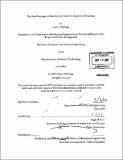| dc.contributor.advisor | Hugh M. Herr. | en_US |
| dc.contributor.author | Wellings, Peter J. (Peter John) | en_US |
| dc.contributor.other | Massachusetts Institute of Technology. Dept. of Mechanical Engineering. | en_US |
| dc.date.accessioned | 2010-04-28T16:57:52Z | |
| dc.date.available | 2010-04-28T16:57:52Z | |
| dc.date.copyright | 2009 | en_US |
| dc.date.issued | 2009 | en_US |
| dc.identifier.uri | http://hdl.handle.net/1721.1/54535 | |
| dc.description | Thesis (S.B.)--Massachusetts Institute of Technology, Dept. of Mechanical Engineering, 2009. | en_US |
| dc.description | Cataloged from PDF version of thesis. | en_US |
| dc.description | Includes bibliographical references (p. 23). | en_US |
| dc.description.abstract | Explosive movements are necessary for many animals to capture prey or escape predators. The movements often require quick bursts of energy that cannot be supplied by muscles alone. Some animals, especially insects, store energy in their tendons by restraining motion with a physical catch, stretching the tendon by flexing the muscle and releasing the energy through the tendon. Since the tendon can release energy faster than the muscle, the peak powers can be much higher. This study asks whether an opposing muscle could be used as the catch in this scenario to restrain the motion. Using a novel apparatus developed in the MIT media lab, a model of this system was simulated using live muscle tissue. It was shown that for loads below 30% of the maximum force of the muscle, using an antagonist muscle as a catch could produce beneficial power amplifications. These amplifications increase as the load and muscle release rates decrease. | en_US |
| dc.description.statementofresponsibility | by Peter J. Wellings. | en_US |
| dc.format.extent | 23 p. | en_US |
| dc.language.iso | eng | en_US |
| dc.publisher | Massachusetts Institute of Technology | en_US |
| dc.rights | M.I.T. theses are protected by
copyright. They may be viewed from this source for any purpose, but
reproduction or distribution in any format is prohibited without written
permission. See provided URL for inquiries about permission. | en_US |
| dc.rights.uri | http://dspace.mit.edu/handle/1721.1/7582 | en_US |
| dc.subject | Mechanical Engineering. | en_US |
| dc.title | The use of antagonist muscle as a "catch" in explosive movement/ | en_US |
| dc.type | Thesis | en_US |
| dc.description.degree | S.B. | en_US |
| dc.contributor.department | Massachusetts Institute of Technology. Department of Mechanical Engineering | |
| dc.identifier.oclc | 565950068 | en_US |
